One can find quite a number of news articles like this one in Politico from 2024:

Or this one in Foreign Policy from 2021:
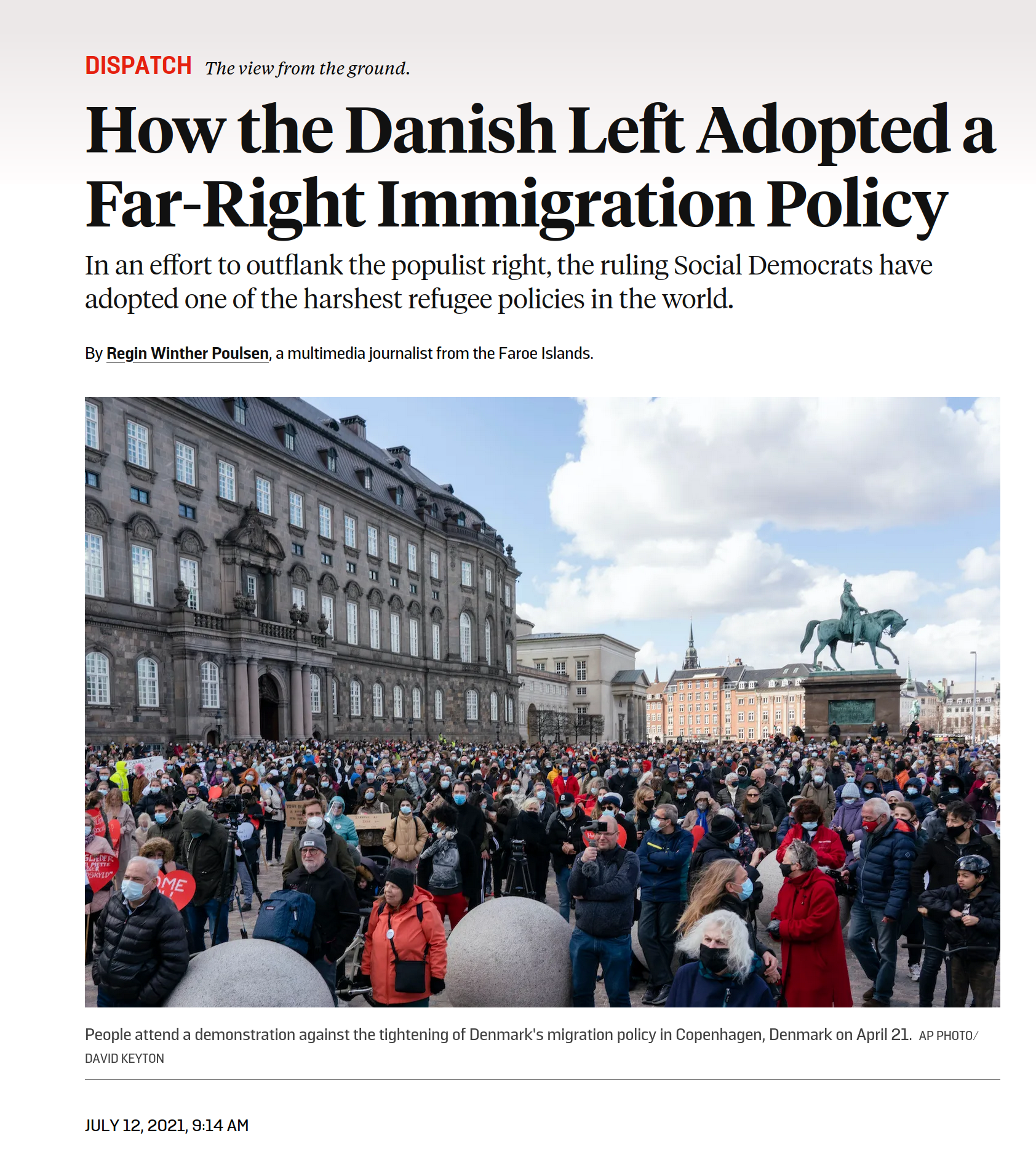
Or this one in The Irish Times from 2021:
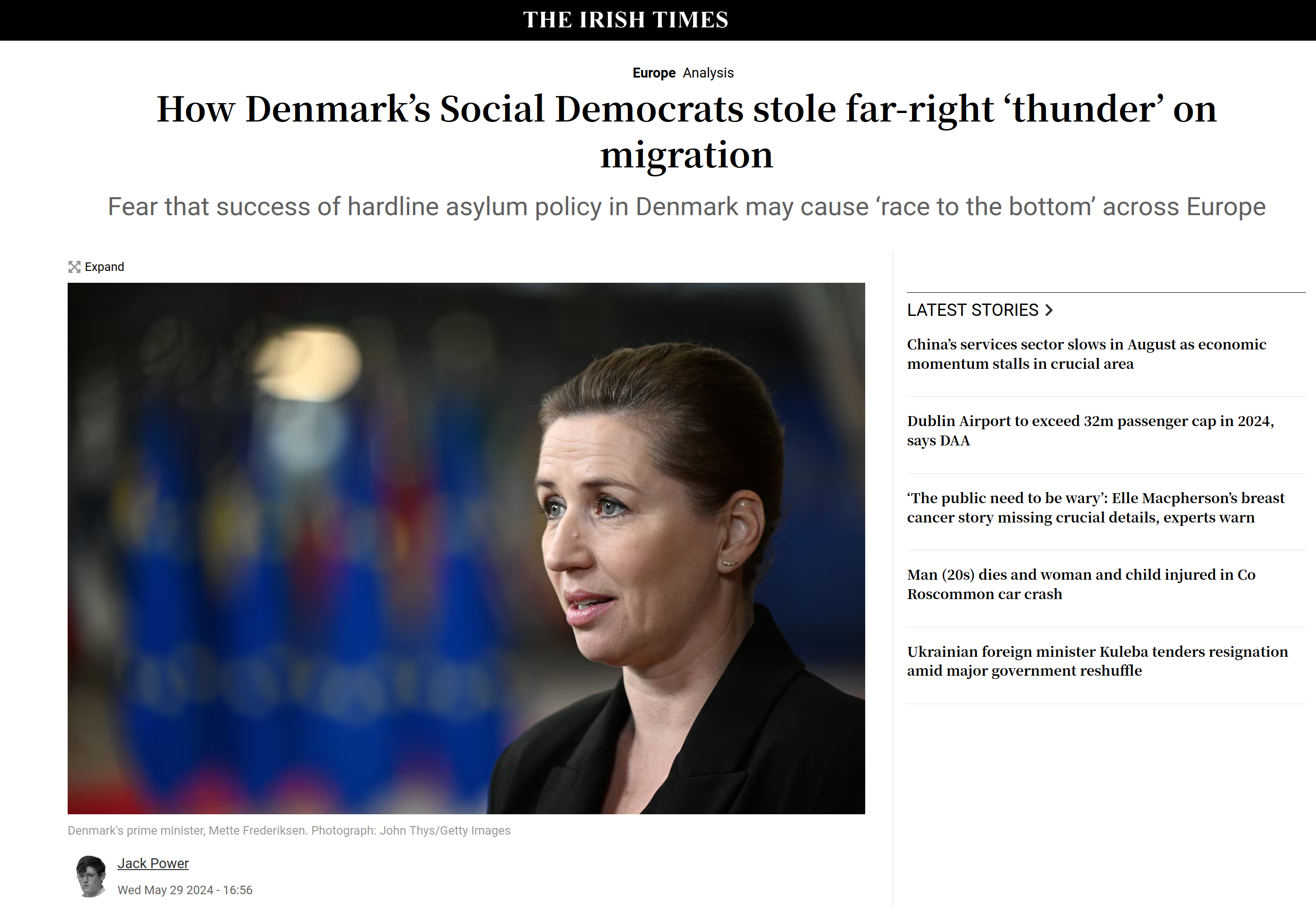
In the end, what matters is not what the Social Democrats say, but what they do, and what happens. So let’s explore this. Denmark makes it easy because the official stats agency has a website with many data tables, so one can easily look up specific data concerning immigration. It’s in English too, so you can also do this. And it has a built-in plotting function. So let’s explore a few of these tables.
First, population size by country of origin. This includes most second generation individuals. Danish government statistics uses a Western vs. non-Western breakdown. The non-Western category is mostly Africans, Arabs, Turks, and generally Muslims, the main groups that create problems. There’s a small number of south, southeast and northeast Asians included in the same grouping, and they aren’t much of a problem. There’s also quite a number of Ukrainians. First, the definition of Western is thus:
- Western countries include: EU, Andorra, Australia, Canada, Iceland, Liechtenstein, Monaco, New Zealand, Norway, San Marino, Switzerland, UK, USA and Vatican City.
- Non-Western countries include: the European countries, Albania, Bosnia and Herzegovina, Belarus, Yugoslavia, Kosovo, Macedonia, Moldova, Montenegro, Russia, Serbia, Soviet Union, Turkey and Ukraine. All countries in Africa, South and Central America and Asia. All countries in Oceania (except Australia and New Zealand) as well as stateless.
So non-EU old communist countries are counted as non-Western. This is particularly important for Ukraine given the migrants from there due to the war. Regarding the classification into immigrant or descendant vs. ‘Danish’, it works as follows:
- Immigrants are born abroad. One or both parents can either be born in Denmark or have Danish citizenship, but not both.
- Descendants are born in Denmark. One or both parents can either be born in Denmark or have Danish citizenship, but not both.
- Persons of Danish origin can be born both in Denmark and abroad. At least one parent was both born in Denmark and has Danish citizenship.
So mixed origin people count as Danish (e.g. one Turkish and one Danish parents count as Danish). This means the number of Danes is somewhat overestimated and number of foreigners somewhat underestimated.
As of 2022, the total population distribution looks like this:
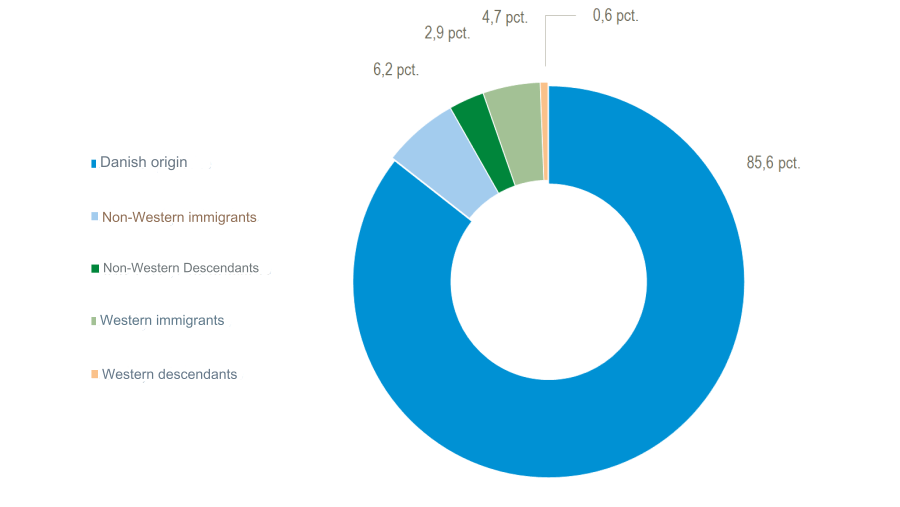
The timeline looks like this (table FOLK2):
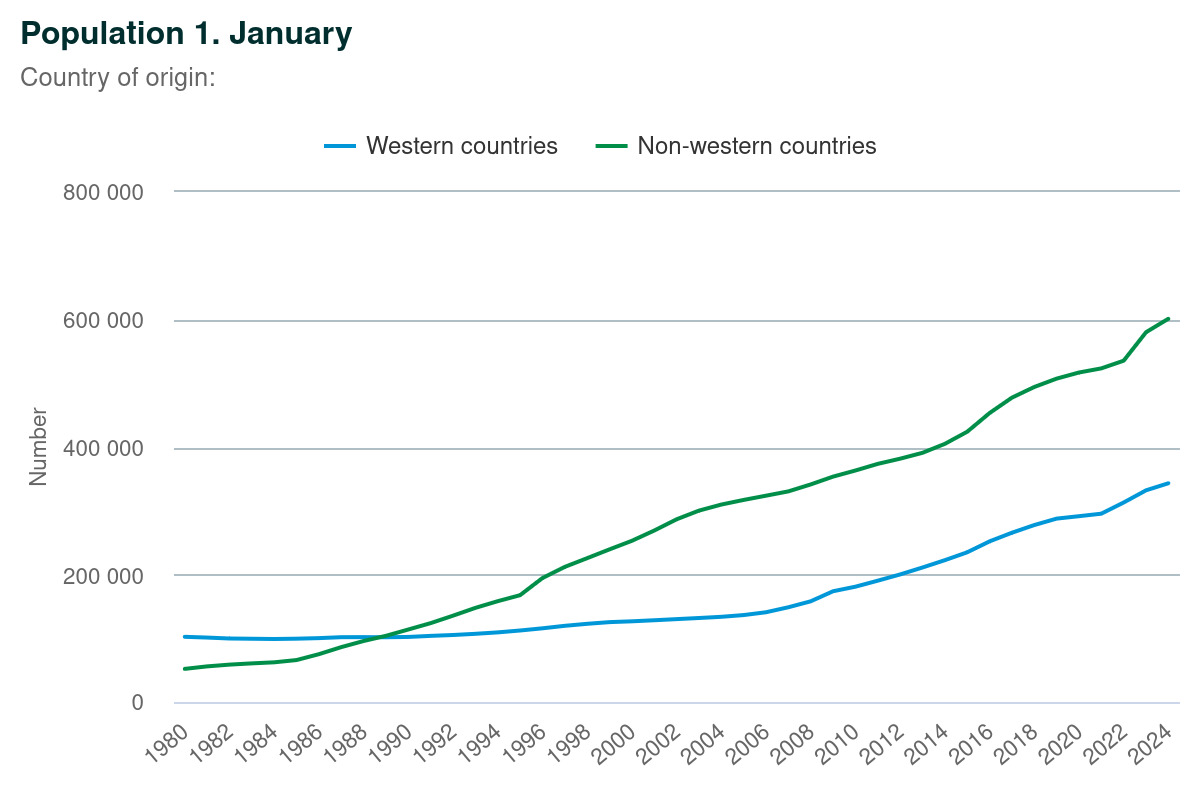
Or by ‘continent’:
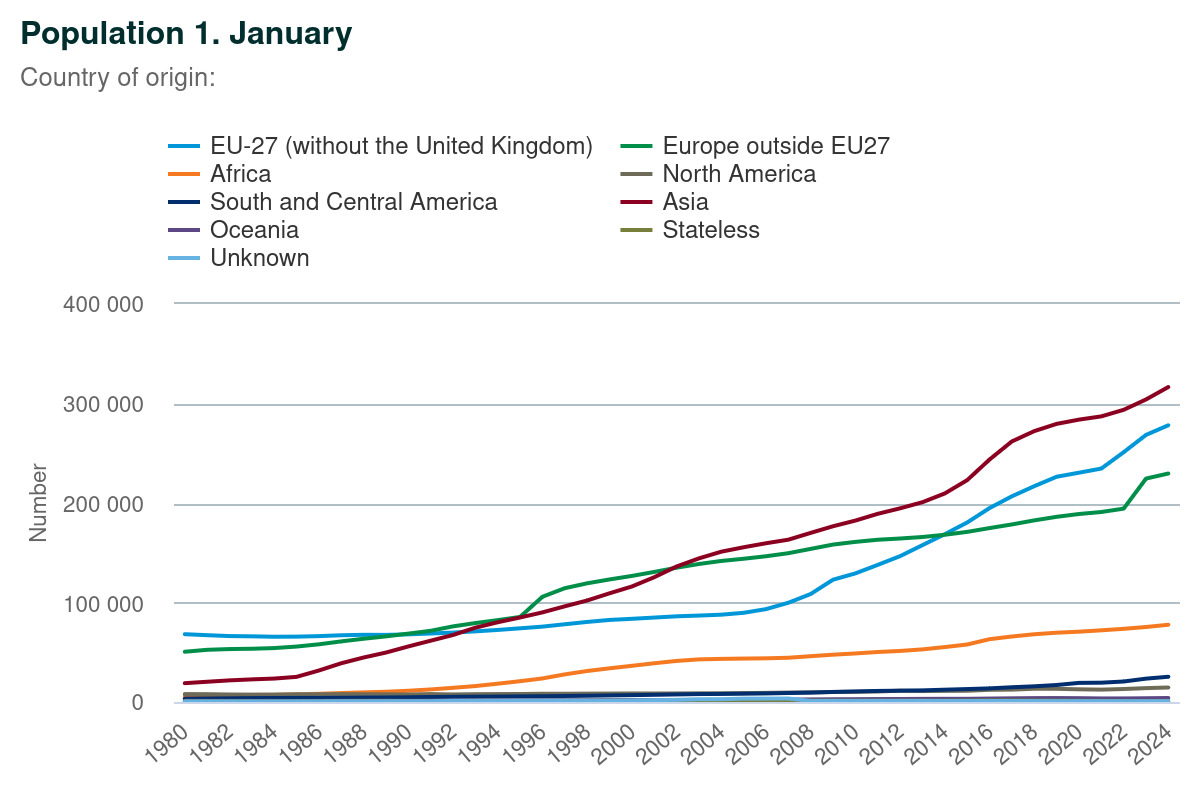
The “Asia” category is doing a lot of work here, typical of UK statistics to misleadingly group Arabs from Syria with Chinese.
Some people on Twitter criticized this figure because the increase could be due to fertility instead of new migrants coming in. So let’s look at resident permits (table VAN66). This shows the number of residents permits granted that year: 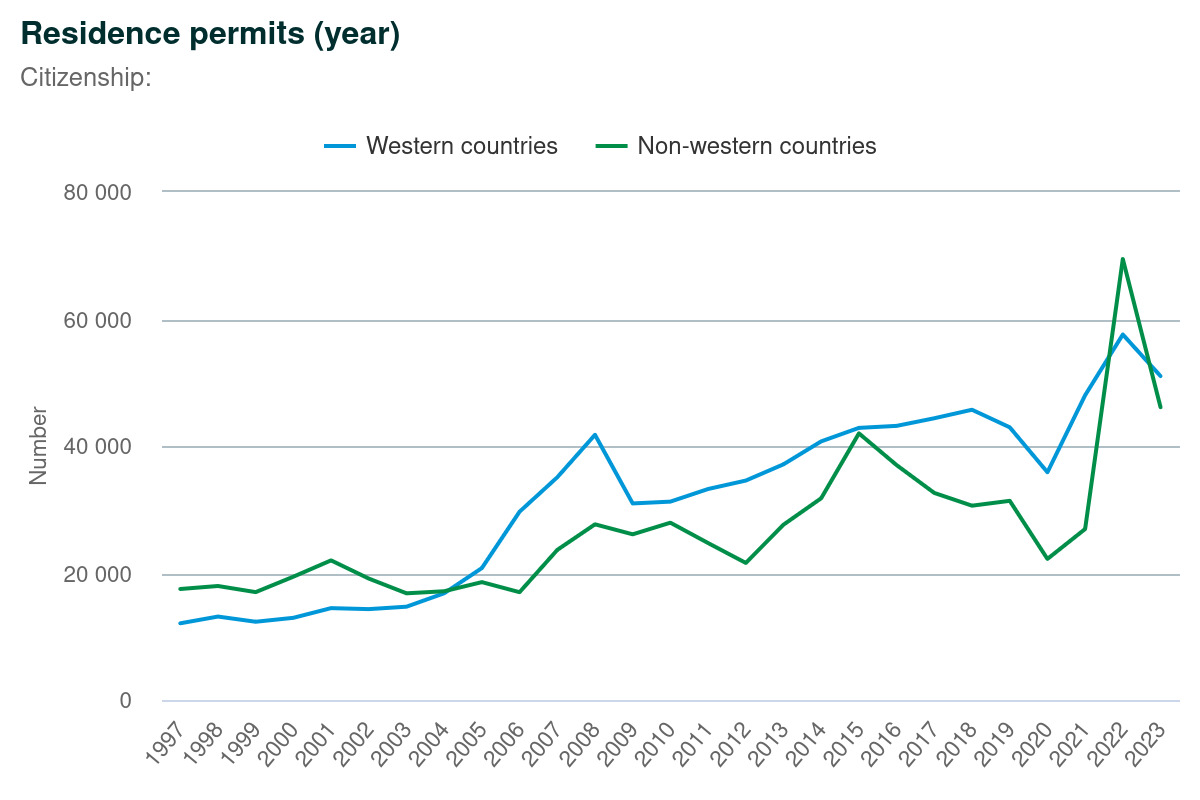
There’s a bit spike in 2022 due to the Ukraine war. We can see this when we use the continents breakdown:
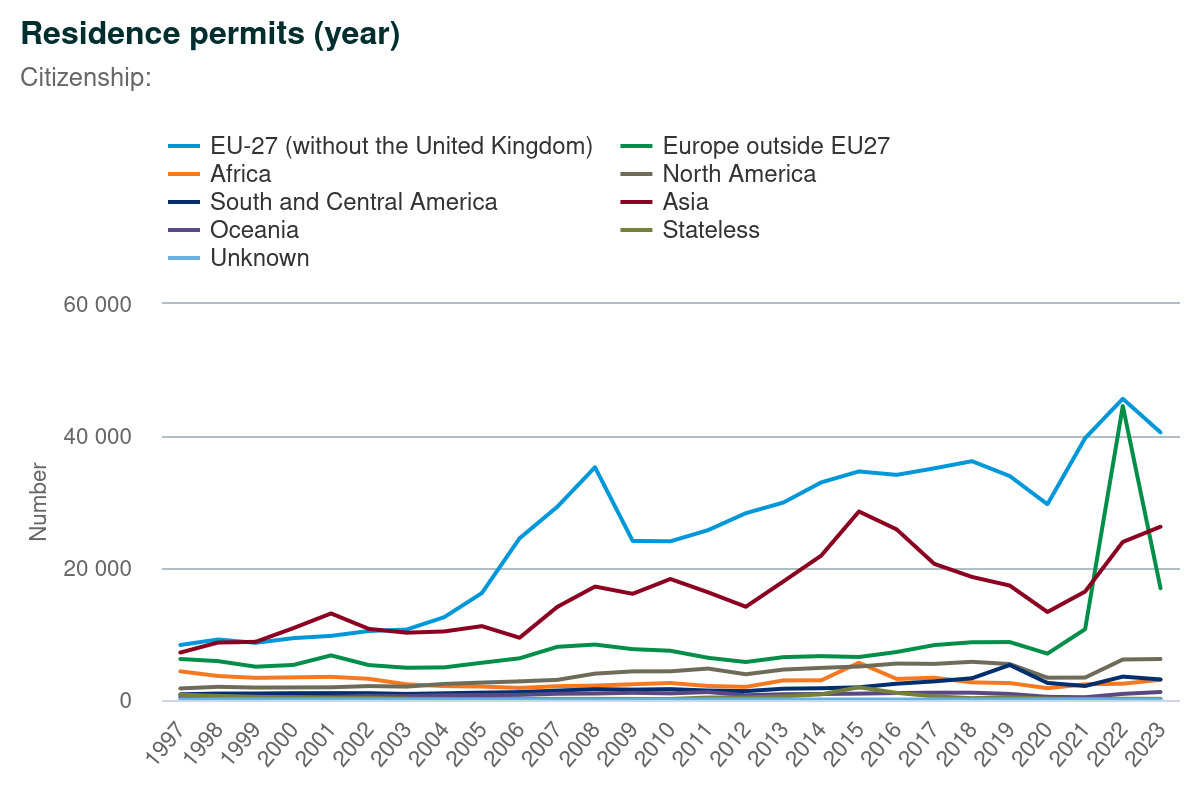
The large green spike (non-EU Europe) is mainly Ukrainians. Notice how the Asia category is almost as high in 2023 as it was in 2015! Only the COVID slowdown could decrease the flow to 2010 levels.
Alternatively, we could look at total immigrations, that is, new arrivals, even if they have not so far been granted residence permit or have been rejected (table VAN8A):
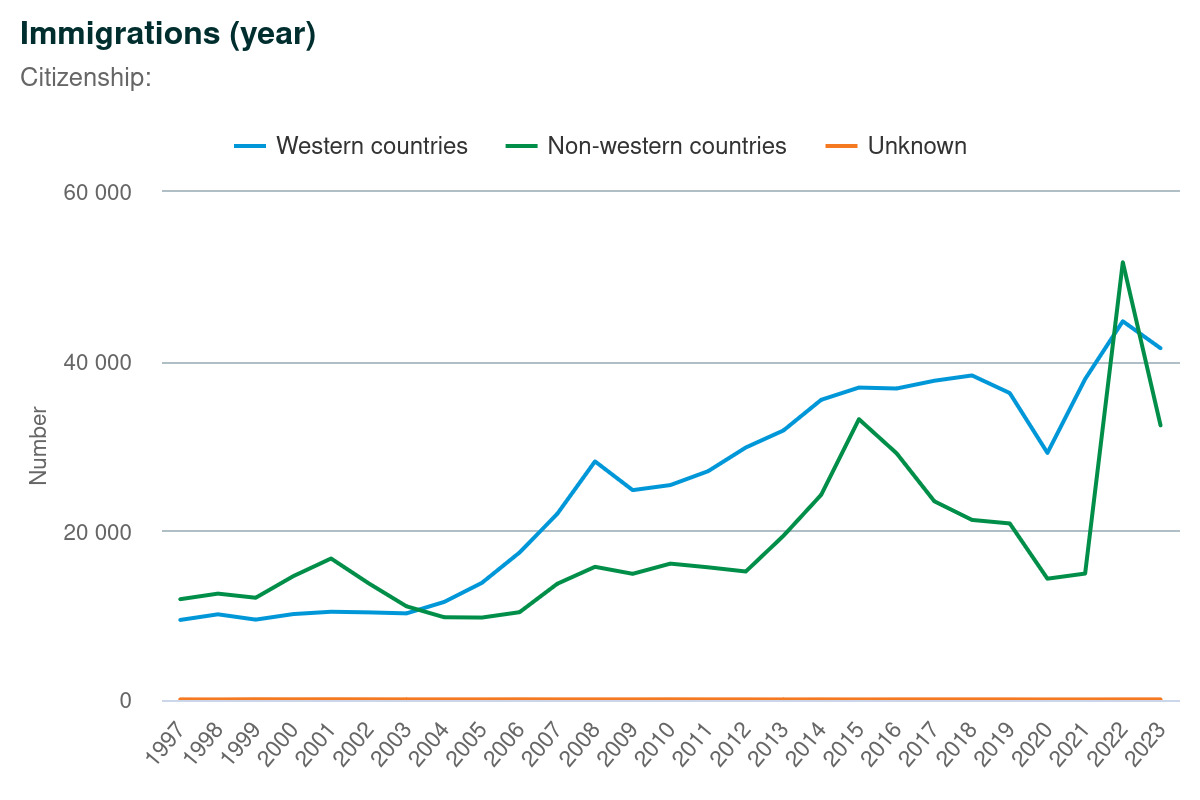
It shows about the same as above, a big spike in 2022 due to Ukraine war. Let’s also look at the continents to be sure:
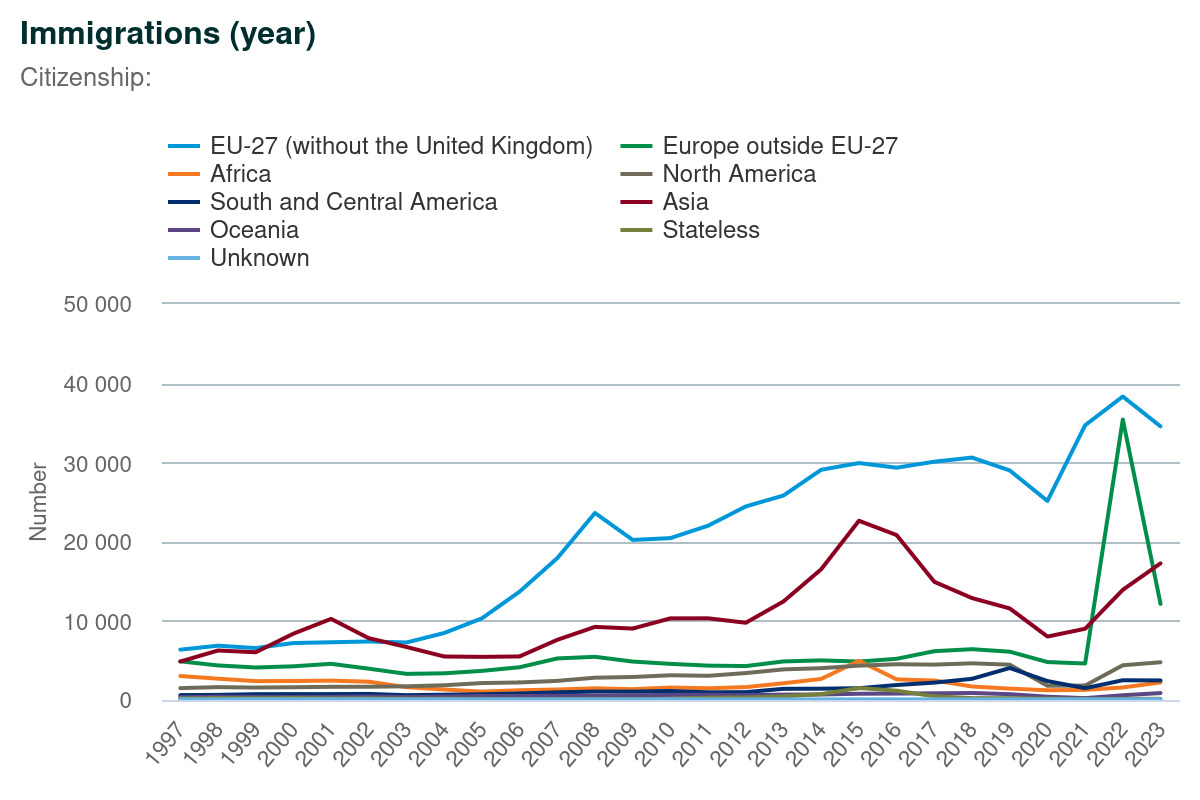
Same thing.
To be fair, it is true that non-Ukraine related asylum seekers have drastically declined:

Ukrainians have a special law enabling their migration, and the others go into the ordinary categories.
The fact of the matter is that not much has changed under the so-called right wing Social Democrats. There are now over 600,000 non-Westerners in Denmark. Denmark is a tiny country. The total number of foreigners is approaching 1,000,000, which considering there are only 5,000,000 Danes, is quite a lot. I will give them that the asylum seeker numbers have declined, but apparently, they just moved to another legal category. So let’s finally, look at the immigration legal basis for the “Asian” immigrants:

The main three pathways in 2023 are: work (5000 people), study/education (5000), and “Study etc., Other reasons” (3400 people).
An actual success of Danish nationalist policies would mean that the first figure, total number of non-Westerners, would start decreasing. Considering the trends we see, this would require a drastic change in policy. Some of the nationalist parties (we have 3 now) have semi-explicit goals in this direction. Here’s the Danish People’s Party (Dansk Folkeparti, DF):
Repatriation
In the long term, we strive to deport all immigrants who cannot or will not allow themselves to be integrated into Danish society.
All the immigrants who have come to Denmark over the years, but who have never managed to settle into our society, must therefore be sent home as soon as possible.
Conventions are suffocating us
Various international conventions such as; The European Convention on Human Rights (ECHR), the Stateless Persons Convention and the Refugee Convention unfortunately create more challenges for Denmark than actual sensible solutions. For example the ECHR prevents in far too many cases that we can deport criminal aliens due to their right to family life. And that despite serious and dangerous crime against Danes.
We want to either change these conventions or completely withdraw from them. Because in Denmark we have to be masters of our own house and want to ensure safety and security for the Danes.
Denmark Democrats (Danmarksdemokraterne):
That is why the Danish Democrats are supporters of a strict and sensible immigration policy. And therefore must we have control over the influx of asylum seekers into Denmark. Migrants who do not have the right to stay in Denmark must sent out of the country. The refugees, as Denmark takes in, must know from the start that it is about temporality. They must travel back to their home countries again as soon as possible. It is important to pursue a strict immigration policy, especially in light of the large migrant flows that challenge Europe.
The Danish Democrats will stop the lucrative business of human traffickers, and wishes therefore to establish reception centers for asylum seekers i third countries.
A return policy is necessary
Every single year since 1983, the share of non-Western migrants in Denmark has grown sharply.
In 1980, the proportion of people with a non-Western background was 1%. In 2024, the proportion is at least 10.1%.
New Citizens want a full stop to Muslim immigration.
But even if we stopped all immigration from Muslim countries tomorrow, the proportion of Muslims would still grow due to their higher birthrate.
If we want to solve the immigration policy from the ground up and stop population replacement, we must dare to discriminate against those who actually constitute the problem.
From now on, Muslims must leave Denmark – not immigrate.
Will they succeed? Here’s the current polls of polls:

The nationalist parties from above are: DD (Denmark Democrats) at 10%, Danish People’s Party (DF) at 4%, and New Right (Nye Borgelige, NB) at 1%. In total, they have 15%. This is pitiful compared to the previous heyday of the Danish People’s Party. The latter two parties are plagued by infighting and typical right-wing incompetence of the type the ‘elite human capital’ people talk about, and that’s why their polls are so low right now. The founder and leader of the latter party even joined the libertarian party (Liberal Alliance, LA). That party is doing well in the polls due to competent youthful people having taken over. Unlike the hopeless American open borders libertarians you see on Twitter, here’s the Danish libertarian party’s immigration policy:
Stop spontaneous asylum and deport criminals
If the Danish asylum system is to be able to hold together, we have to put an end to the spontaneous asylum applications. The relatively wealthy people who can afford to come to Denmark should not be able to come to Denmark via spontaneous asylum and receive benefits at the expense of those who have worse conditions. If we stop spontaneous asylum applications, we can instead use our resources to take in a limited number of quota refugees and help the refugees in their immediate area.
Finally, we must have a far tougher immigration policy towards foreigners who break the law. If, as a foreigner, you cannot keep within the framework of the law and commit crimes, it is a clear signal that you do not respect our society and norms. Therefore, as a starting point, we must deport foreigners who commit serious crimes. On that point, we are not at all tough enough today.
Baby steps.
Overall, based on my reading of Danish politics and our neighbors in Sweden and Germany, we are much more open about various options, but in practice, we haven’t accomplished much. The Overton window includes the policies needed to make a real difference, but will voters vote for this? It remains to be seen.
